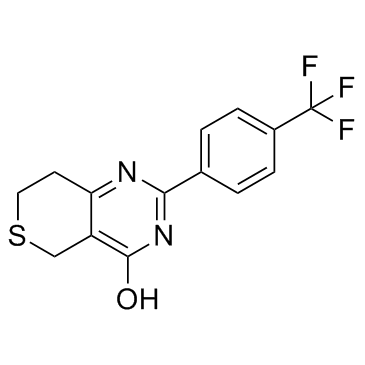284028-89-3
| Name | 2-[4-(trifluoromethyl)phenyl]-1,5,7,8-tetrahydrothiopyrano[4,3-d]pyrimidin-4-one |
|---|---|
| Synonyms |
3,5,7,8-Tetrahydro-2-[4-(trifluoromethyl)phenyl]-4H-thiopyrano[4,3-d]pyrimidin-4-one
2-[4-(Trifluoromethyl)phenyl]-1,5,7,8-tetrahydro-4H-thiopyrano[4,3-d]pyrimidin-4-one XAV939 XAV 939 4H-Thiopyrano[4,3-d]pyrimidin-4-one, 3,5,7,8-tetrahydro-2-[4-(trifluoromethyl)phenyl]- NVP-XAV 939 2-[4-(trifluoromethyl)phenyl]-7,8-dihydro-5H-thiino[4,3-d]pyrimidin-4-ol XAV-939 |
| Description | XAV-939 is a tankyrase (TNKS) inhibitor and an indirect inhibitor of Wnt/β-catenin signaling, with IC50s of 5 and 2 nM for TNKS1 and TNKS2, respectively. |
|---|---|
| Related Catalog | |
| Target |
TNKS1:5 nM (IC50) TNKS2:2 nM (IC50) ARTD1:5500 nM (IC50) ARTD2:479 nM (IC50) |
| In Vitro | XAV939 (1 μM) strongly inhibis STF activity in SW480 cells, Wnt3a-stimulated STF activity in HEK293 cells, but does not affect CRE, NF-κB or TGF-β luciferase reporters. XAV939 regulates axin levels through tankyrase inhibition in HEK293 cell[1]. XAV939 (0.5 μM, 1.0 μM) reduces DNA-PKcs protein levels 50% of the relative DMSO control in human lymphoblasts[2]. XAV939 induces a second wave of pro-cardiomyocyte gene expression as shown by increased Mesp1 and Isl1expression 2 to 4 days after Wnt inhibition, and by increased Nkx2.5 expression 4 to 6 days after XAV939 addition[3]. XAV-939 (10 nM) has a suppressive effect on elevated MMP-13 levels in both IL-1β-induced SW 1353 cells[4]. |
| In Vivo | XAV-939 (3 mL, 10 nM) has a suppressive effect on elevated MMP-13 levels in the rat OA model[4]. XAV-939 (1 mg/mL, i.p.) ameliorates the psoriasiform skin disease induced by IMQ. XAV-939 results in a significant decrease in the IMQ-induced epidermal hyperplasia (indicated by acanthosis) and dermal inflammatory infiltrates in mice[5]. |
| Kinase Assay | To assess the effect of compounds on auto-PARsylation of TNKS, 1 μM GST fusion protein containing the SAM domain and the PARP domain of TNKS2 (a.a. 872-1166) is mixed with 5 μM biotin-NAD+ and 2 μM XAV939 or LDW643 at 30°C for 2.5 hours. Samples are resolved by SDS-PAGE and probed with streptavidin AlexaFluor680. To assess PARsylation of axin, recombinant full-length TNKS2 (expressed/purified as a N-terminal His-tagged protein in bacteria) is incubated with GST-axin 1 (1-280) in the presence of biotin-NAD+ with or without XAV939. The products are resolved and probed with Streptavidin-HRP and imaged using a AlphaInnotech imager. To assess the effect of XAV939, IWR-1-enod, IWR-1-exo, and ABT-888 on auto-PARsylation of TNKS2, His-tagged full-length TNKS2 is incubated with 5 μM biotin-NAD+ and 3 mM of indicated compounds. The products are resolved and probed with Streptavidin-HRP. LC/MS-based high throughput auto-PARsylation assays for PARP1, PARP2, TNKS1, and TNKS2 are setup to monitor the formation of nicotinamide (a by-product of the PARsylation reaction) in the presence of small molecule inhibitors. |
| Cell Assay | Human SW 1353 chondrosarcoma cells are seeded in 96-well plates (1×104 cells/well) and are treated with Icariin (0, 5, 10, 20, 40, 80, or 100 μM). After 24 h, 20 μL MTT (5 mg/mL in PBS) is added to each well and plates are incubated at 37°C for another 4 h. Supernatants are then removed, and 150 μL dimethylsulfoxide is added to each well. After plates are shaken for 10 min, optical density values measured at 570 nm are recorded using an ELISA reader. |
| Animal Admin | C57BL/6J mice are kept under specific pathogen-free conditions. XAV-939 is injected i.p., at a dose of 1 mg/mL, once a day for seven consecutive days of IMQ treatment (injection volume 100 mL). Control mice are injected with 100 mL 10% DMSO/90% 0.9% NaCl, the solvent for XAV-939. To ameliorate any suffering of mice observed throughout these experimental studies, they are euthanized by CO2 inhalation. |
| References |
| Density | 1.5±0.1 g/cm3 |
|---|---|
| Boiling Point | 429.3ºC at 760 mmHg |
| Molecular Formula | C14H11F3N2OS |
| Molecular Weight | 312.310 |
| Flash Point | 213.4ºC |
| Exact Mass | 312.054413 |
| PSA | 71.31000 |
| LogP | 2.98 |
| Appearance | white to beige |
| Index of Refraction | 1.634 |
| Storage condition | Store at RT |
| Water Solubility | DMSO: soluble5mg/mL, clear |
| Symbol |

GHS06 |
|---|---|
| Signal Word | Danger |
| Hazard Statements | H301-H319 |
| Precautionary Statements | P301 + P310-P305 + P351 + P338 |
| Hazard Codes | T |
| Risk Phrases | R25;R36 |
| Safety Phrases | S26-S45 |
| RIDADR | UN 2811 |
| Packaging Group | III |
